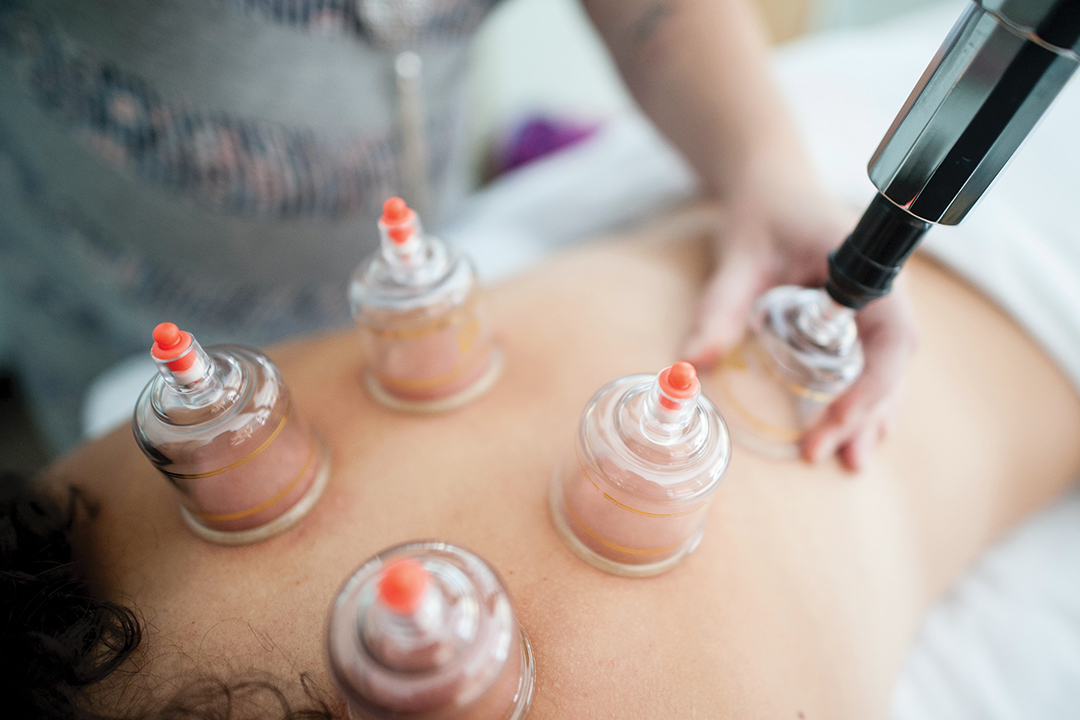Injury prevention and rehabilitative therapies such as cupping and Kinesio Taping® (KT tape) are points of contention in sports medicine and kinesiology. Though scrutinized for legitimacy, these therapies have undoubtedly garnered attention in the athletic community.
Cupping therapy is an alternative therapy that dates back thousands of years and is generally associated with the traditional medicine of several ancient Chinese, Egyptian, and Middle Eastern cultures. Though modern cupping conventions have emerged, cupping traditionally involves various-sized cups typically made of glass.
These materials are used in tandem to create a vacuum on the skin’s surface, which suctions skin and muscle tissue to a localized area. The suction draws fluid to the localized area in an attempt to increase circulation. The cups are then removed, which reveals discoloration — due to damaged blood vessels — underneath.
The world’s most decorated olympian Michael Phelps brought cupping into the spotlight during his campaign at the 2016 Olympic Games in Rio de Janeiro, when he won five gold medals in the men’s swimming competitions.
During these games, Phelps was seen repeatedly with distinctive circular, dark-purple markings on his back, a common side effect for those who receive cupping treatments. The swimmer clarified that the markings were indeed from cupping therapy, which he said was common practice for him in preparation for competition.
Perhaps this sight was enough proof to skeptics that cupping possesses some benefits relating to athletic performance, but what does the scientific community think? Many doctors and experts in sports science believe there is insufficient research indicating any benefits from cupping therapy.
In contrast, others believe that the relevant scientific literature of the past decade has presented enough evidence to deem cupping as a valid means of treatment for some pain conditions. Exactly how it helps is another question: many proponents of cupping therapy believe that it relieves pain by removing toxins from the body and therefore improving Qi energy flow. This notion, however, is not scientifically proven and the causal explanation for the benefits acknowledged in research studies remains obscure.
A more modern alternative therapy is KT tape, a drug-free form of athletic tape that, according to the company, improves muscular and joint fitness while facilitating recovery of various injuries.
Two-time Canadian olympian and world beach volleyball champion Sarah Pavan is a huge proponent of KT tape. With her recent signing to join the company’s roster of sponsored athletes and her endorsement of similar products on social media, Pavan has made her support for the product evident.
Similar to cupping therapy, there is a lack of high quality research examining the product’s efficacy in injury prevention and pain relief. A study published in the Journal of Physiotherapy concluded that the research team did not support using KT tape in clinical practice. Another study published in the Brazilian Journal of Physical Therapy deduced that the effects of KT tape on patients with non-specific low back pain were similar to those of a placebo.
Although most scientific literature does not support KT tape, some studies indicate that the product may decrease joint irritation and increase blood flow. The lack of convincing research has not slowed down the product’s rise in popularity because much of KT tape’s promotion comes anecdotally, from athletes like Pavan. A vital question is whether those who endorse the product are financially motivated or genuinely see merit in using the product.
Debates concerning rehabilitative therapies are not limited to those mentioned above. There is an abundance of therapies that face a similar amount of scrutiny, such as cryotherapy, which is a treatment that uses low temperatures, and intravenous hydration, in which fluid is injected into the body to treat dehydration. It is vital for therapeutics to face thorough investigation, especially when it involves the gargantuan athletics industry. This investigation is particularly crucial when it involves claims of improving and prolonging an athlete’s career.
Effective or not, there is clearly a demand for anything that may improve one’s rehabilitation and fitness, even if only slightly. Altogether, when it comes to these controversial therapies, their acceptance relies on consumer choice and one’s openness to the risk of relying on pseudoscience.


